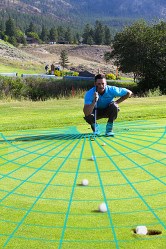
It's as true on the putting green as anywhere else: The shortest distance between two points is a straight line. On the green, however, the shortest route isn't always the best one.
Most putts of three or more feet in length have at least a little break (curve) to the right or left, which must be accounted for when deciding where to aim and how hard to hit the ball.
There are two schools of thought on how to handle breaking putts. One method is to stroke the ball gently so that it “dies” in the hole, which requires playing the maximum amount of break. The other is to hit the ball harder and more directly at the hole, eliminating some or all of the break.
Both tactics have plusses and minuses. Dying your putts requires a delicate touch and refined green-reading skills; when charging putts, you run the risk of running well past the hole on a miss.
Here's a short primer on factors that influence how aggressively to putt:
- Green speed: On very fast greens, it's best to play lots of break and die your putts. On slower greens, play less break and give putts a good rap.
- Slope: Downhill putts are faster and break more, so a light stroke is best. Uphill putts are slower and break less; charge them.
- Length: On putts inside four feet, play as little break as possible and knock the ball into the back of the hole. It's best to respect the break on longer putts.
Speed control is one of the key elements of successful putting.

Most golfers obsess over the line when getting ready to hit a putt, but the speed you choose to use is just as important. Your putts are only going to be successful when you manage to match up your chosen line with the right speed for the job. If you get one of the two halves of any putt wrong, the ball is not going to find its way into the bottom of the cup.
In this article, we are going to talk about a couple of different speed options you have on the greens. On any given putt, you can attempt to let the ball die just as it reaches the hole, or you can try to ram it into the back of the cup. Each of these options has benefits, and each comes with some drawbacks. Unfortunately, we can't tell you which one is 'better' than the other, because they can both work. Among the professional ranks, there are players which fall into each category. Some high-level golfers tend to be aggressive on the greens, while others usually roll the ball gently up toward the hole.
For most players, it is going to be best to pick one of these two strategies to use as your go-to option. Technically, you could switch back and forth between these methods based on the putt at hand, but that is going to be tricky. It's hard enough to dial in your speed control when using just one putting style – it is nearly impossible when using two. Part of our goal in this article is to help you determine which of the two methods of putting is going to make the most sense for your game.
All of the content below has been written from the perspective of a right-handed golfer. If you happen to play left-handed, please take a moment to reverse the directions as necessary.
Pros and Cons of the Conservative Approach

If you let the ball run out of speed just as it is approaching the hole, you are taking the conservative approach to putting. That isn't meant as a criticism – this can be a great way to putt. In fact, while we aren't going to declare one of these putting methods as being better than the other, we would argue that this is the approach which will work best for most amateur players. Let's take a look at some of the pros and cons associated with letting the ball die the ball right at the hole.
- Pro – Take away some stress. If you are consistently running your putts a few feet past the hole, you are going to have to sweat those comebackers all day long. You may make most of them – or even all of them – but that doesn't mean they are harmless. The extra mental energy you have to exert to knock in those comeback putts may wear you down, leading to silly mistakes later in your round. If you choose to die the ball by the hole, you will be able to tap-in the putts you don't make, taking away much of the stress you could otherwise find on the greens. For many of the people who choose to putt this way, removing the stress of the comeback putt is a big selling point.
- Con – Potential to leave putts short. If you plan to have the ball run out of speed just as it reaches the cup, there is always the chance that you will misjudge the speed just slightly – and the ball will actually stop before it reaches the hole. This is extremely frustrating, especially when the ball was rolling on a line that would have caused it to fall it. While it never feels good to leave a putt short, you have to accept this possibility if you decide to putt with cautious speed.
- Pro – Use the entire hole. Speaking of frustrating experiences on the greens, another outcome which can leave you annoyed is seeing a putt hit the edge of the hole – only to spin out on the other side. These lip-outs are just as frustrating as leaving putts short, but you can limit their frequency by using gentle speed. Without much speed left when the ball arrives at the hole, your putt won't need to grab much of the cup in order to fall in. It is usually more aggressive putts that are prone to lip-out, so you shouldn't see nearly as many of these when you take some of the pace off the ball.
- Con – Need to read the putt perfectly. You are going to have to get your read just right if you are going to make a breaking putt while using conservative speed. Since the ball will be rolling slowly, it will have plenty of time to take all of the slope that the green has to offer. This isn't a big deal when playing putts with a large degree of break, as you would always play those kinds of putts conservatively. Where this issue is seen is on those putts with a relatively subtle break. Players who use an aggressive speed can aim more directly at the hole, knowing the pace of the putt is going to straighten out its path. You don't have that luxury when using soft speed, so you'll have to account for every last inch of possible break. Developing your green reading skills is one of the key components to having success with this style of putting.
- Simplicity. When you choose to use this method of putting, your decision-making process prior to each putt is going to be very simple. You will already know that your plan is to die the ball right around the cup, so the only thing you need to think about is the line of the putt. This gives a great simplicity to the putting process, and simplicity is something that you should take anywhere you can get it in this difficult game. Those who use a more aggressive approach will not enjoy this simplicity, as they'll always have to check to make sure the 'coast is clear' for an aggressive putt. If the green runs away beyond the cup, for instance, an aggressive putter will have to back off and come up with a different plan. You won't have these worries with your gentle speed, so you can just pick a line and go for it.
There is a lot to like about putting with a speed that lets the ball die right at the cup. It's not a perfect method, of course, as the potential to leave putts short and the need to get a perfect read can be seen as obvious drawbacks. In the end, however, many golfers have been successful with this approach over the years, and it just may be the best bet for you.
Pros and Cons of Being Aggressive

It would be a mistake to settle on a conservative putting plan without first exploring the opposite end of the spectrum. Even if you have reasonable success with a gentle putting style, you won't know if it is the best option for you until you spend some time thinking about – and testing – the other option. Just as was the case in the previous section, this section is going to consider the pros and cons of attempting to ram the ball into the back of the hole on most of your putts.
- Pro – Reduce the break. On many putts, you'll need to play less break when you use a more aggressive speed. Since the ball will be moving quicker as it heads toward the hole, it isn't going to have as much time to turn down the slope. Since there is going to be less side-to-side movement in most of your putts, your reads will be simpler. This is one of the main reasons that many golfers decide to play aggressively on the greens. Rather than trying to decipher a complicated read, you just use more speed and play your putts as directly as possible.
- Con – Three putting. This is the obvious downside of deciding to use an aggressive approach on the greens. When you charge the ball up toward the cup with plenty of speed, some of those putts are going to race on past – and you might not always make the next putt coming back. The three putt greens that result from aggressive putting may wind up offsetting any gains you enjoy from additional makes. Sure, you won't be leaving any of your putts short, but are you going to be able to knock in all of those tricky comebackers? That's the question you'll need to answer when thinking about being an aggressive putter.
- Pro – Playing with confidence. Many amateur golfers play the game in a timid, scared state of mind. They are trying to avoid making any mistakes at all, so they just carefully push the ball around the course. You might be able to keep your ball in play this way, and you may avoid major mistakes, but will you live up to your potential? Maybe not. By using an aggressive approach on the greens, you may put yourself in a mindset that translates throughout the rest of your game. Suddenly, you may find that your full swings are filled with confidence, and your overall game improves.
- Con – Pressure situations. Even if you don't play in formal golf competitions, you are sure to feel pressure on the course from time to time. For example, you might be getting toward the end of your round with a chance to shoot your all-time best score. If you get nervous, are you going to have the confidence to stick with your aggressive putting speed? You might find yourself deviating from your plan when faced with a tight spot, as you don't want to make a costly mistake at the wrong time. Of course, changing your putting style mid-round is never a good idea, so you'll need to be sure that you have the confidence to stick with this technique even when the heat is on.
- Pro – Overcome questionable greens. When the greens aren't in great shape, those who putt with a gentle pace on the ball can run into trouble. Slower putts are going to take more of the bumps along the way, meaning the ball will likely be tossed off line at one point or another. By keeping your speed up, you may be able to ride out the rough spots on the putting surface with a little more success. Hitting your putts hard isn't going to automatically cause your ball to roll perfectly, of course, but it can help on those days when the greens are a bit rough.
Hitting aggressive putts takes confidence, but it can pay off for golfers who have the nerve to make it work. Will this be the right plan for all players? Absolutely not. For some, the risk of racing the ball past the cup is simply going to be too concerning. Many players feel more comfortable leaving themselves with tap-in second putts, even if that means coming up short with their first putt from time to time. You are only going to be successful with this bold putting plan if you truly believe in it, and believe in yourself. At the heart of the matter is this – you have to be supremely confident in your ability to make those comeback putts. If you think you can knock in your comebackers time after time, aggressive putting may suit you nicely.






